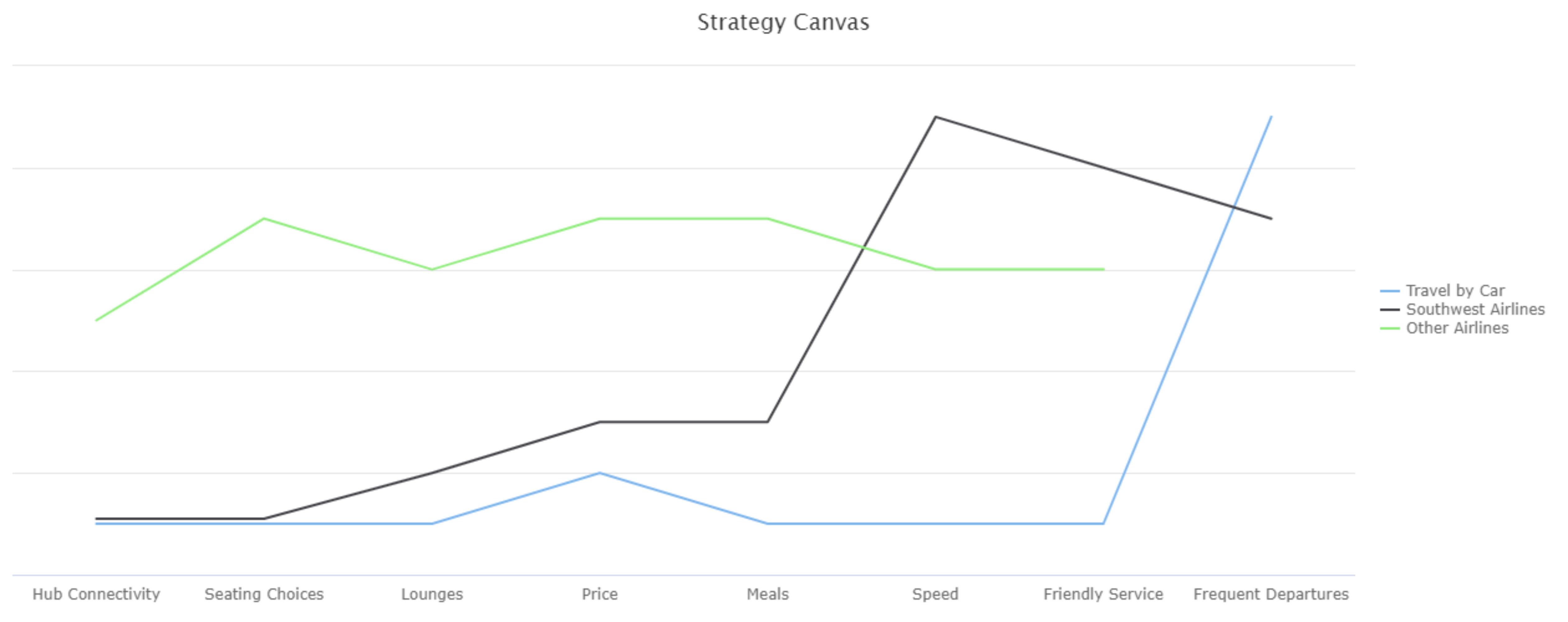The Strategy Canvas was popularised by W. Chan Kim and Renée Mauborgne in their popular book "Blue Ocean Strategy: How To Create Uncontested Market Space And Make The Competition Irrelevant".
Strategy Canvases provide a simple way of visualising how your competitors attract customers, and/or how your customers choose the product or service they buy in your category. This allows you to differentiate yourself by choosing a different combination of factors on which to compete.
In very simple terms, for example, if all of your competitors compete on price, you might choose to compete not on price but on quality, by launching a premium brand. In practice, of course, the situation is seldom that simple, and you'll be looking for a unique combination of factors, rather than a single factor alone. And it is here that the Strategy Canvas's visualisation method comes into its own.
The diagram below shows an example of a Strategy Canvas for Southwest Airlines (based on an analysis from "Blue Ocean Strategy"). It shows how Southwest Airline carved out its strategic differentiation by combining the no-frills, no-hassle convenience and cost of travelling by car with the speed and friendly service of an airline. In fact by removing the airlines' add-ons, Southwest was able to improve on the service and speed they offered. There are many case studies on Southwest Airlines which you can read so I won't go into further details here.
The Strategy Map shown above was drawn with StratNavApp.com, the online collaborative tool for strategists. It's free to use, so why not give it a go?
There are 4 relatively simple steps to preparing your own Strategy Canvas.
1. Identify the competition
The first step to drawing a Strategy Canvas is to know who your competition is. In fact, this is essential to any strategic thinking process. Depending on the nature of your industry, you could identify individual competitors by name, or, as in the example above, you might find it easier to cluster them into a smaller number of semi-homogeneous groups. Don't forget to include your own business, whether you are in the market yet or not.
When identifying competitors, it is always important to look at the problem from the customer's perspective - who or what else could satisfy your customer needs? Had Southwest Airlines not done this, they would simply have listed the other airlines, and not realised that, in many cases, customers are choosing between flying and other modes of transport. It is unlikely they would have had the insight that led to their very successful strategy if they had not taken this broader view.
2. Identify the factors of competition
The second step is to identify the factors that your customers value when choosing the product or service you are offering. In the above example, these include the price, meals, lounges, seating choices, etc.
The simplest way to do this is to actually get out and speak to your target customers, but there are many research approaches you could adopt. Remember, it is important to speak to people who already buy your product and service, people who buy it but from your competitor, and people who don't yet buy your product and service but might in the future (especially if your strategy is successful). And don't forget that people don't always know what they want so you may need to get a little creative in order to find out.
3. Evaluate the competition
The third step is to draw the actual chart - draw a line for each competitor/type of competitor showing how well they perform in terms of each of the factors that your customers value.
It is often interesting to do steps 1 to 3 with a team in a closed room, just to see how different peoples strategy maps look in terms of the competitors/groups they select, the factors they consider important, and how they rate the competition. Strategy Canvases prepared on this basis can be significantly different, and the ensuing debate can be a valuable team building and strategising exercise if managed well.
However, once again, you can also ask your customers directly, just by talking to them or using a variety of research techniques, to get a more accurate and objective picture.
See also: 7 straight-forward steps to master competitor analysis
4. Chart your competitive differentiation
Now you are ready to map your new strategy onto the Canvas. The objective is to chart a line which is substantially different to the lines of any of your competitors/groups. That difference, that unique blend of competitive factors, is your competitive differentiation.
Think about:
- Which factors will you increase?
For example, Southwest Airlines increased the frequency of departures. - Which factors will you decrease?
For example, Ikea reduced in-store service. - Which factors will you eliminate?
For example, Southwest Airlines eliminated inflight meals and seating choices. - Which factors will you add?
For example, Ikea added the ability to take furniture home from the store on the day you bought it, rather than ordering and then waiting for manufacture and delivery.
Of course, not just any differentiation will do. You must pick a combination that a sufficient number of your target customers will find compelling, in order to sustain your commercial objectives. You will undoubtedly have to dig deep into your box of other strategy tools to do so.
There is an art to drawing a really useful Strategy Canvas, but with a little practice, you can learn to draw really insightful diagrams. When you do, they are a great tool for communicating simple but powerful strategic ideas.
Why not share your own experiences with Strategy Canvases in the comments below?
See also:


No comments:
Post a Comment